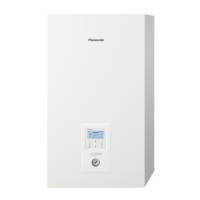16 Aquarea air-to-water heat pumps - Planning and installation manual - 02/2022
Product Description
4
In a circulation process, ambient heat is brought to a higher temperature level. An environmentally-
compatible refrigerant passes through four steps:
● In the evaporator (1), the refrigerant boils and goes from the liquid phase to the
gaseous phase. In this step, heat is extracted from the environment.
● In the compressor (4), the pressure of the gaseous refrigerant is sharply increased,
and the temperature also rises. This step takes place with supply of electrical energy
(2).
● In the condenser (3), gaseous refrigerant condenses and transfers the heat of
condensation to the water to be heated, while it also cools down at the same time.
● When passing through the expansion valve (5), the pressure of the uid refrigerant
drops so abruptly that its temperature drops sharply and it can absorb ambient heat
again.
This circulation process runs continuously and can be controlled using the Inverter Plus technology
of the Aquarea heat pump in such a manner that the current heat requirement is covered.
By inverting the circulation process, it becomes a refrigeration machine. Aquarea heat pumps can
thus also be used for space cooling.
Coecient of Performance and Seasonal Eciency
The Coecient of Performance (COP) of a heat pump for the heating mode is dened as the ratio
of the emitted thermal output to the electrical power consumed and thus says something about the
eciency of the heat pump at a given moment. The COP of heat pumps diers, depending on the
outside temperature and temperature of the generated heat. It is generally true that the COP drops
with increasing the temperature dierence between the outside temperature and the temperature of
the useful heat. A comparison of the eciency of various heat pumps is only possible at the same
temperature. COPs for air-to-water heat pumps are usually measured and stated at the following
temperatures for better comparability:
Outside temperature Useful heat
A–15 W35
A–7 W35
A7 W35
A2 W55
(A stands for Air, W stands for Water)
Example
Coecient of Performance = 5.33 (A7 / W35)
At an outside temperature of 7 °C, the air-to-water heat pump generates hot water at 35 °C with a
COP of 5.33. Thus, it is possible to generate 5.33 kilowatt hours of heat from one kilowatt hour of
power.
A clearer view on a heat pump’s performance under real operating conditions is provided by the
Seasonal Coecient of Performance (SCOP). As specied in EN 14825, the SCOP is dened as
the total reference annual heating load QH divided by the total annual power consumption QHE,
where QHE includes the COPs (measured at dened operating states), the energy consumption
in non-active mode, the rated heating capacity and the duration in active mode (dependent on
three simplied climate zones across Europe based on outdoor air temperatures weighted by their
occurrences in assumed hours per year).
The classication of heat pumps in terms of eciency, which is stated on the EU energy label,
is based on the seasonal space heating energy eciency η
s
, which in turn is calculated from the
SCOP.
Similar to the COP for the heating mode is the power factor for the cooling mode (EER = energy
eciency ratio) dened as the ratio of the emitted cooling power to the consumed electrical power.
10.03.2021, cH
- COP in example adjusted to current “top” model
(WH-ADC0309J3E5+ WH-UD03JE5) => 5,33 (A7/
W35)
- I think that “performance number” is not the
correct expression, must be changed.
- JAZ (Jahresarbeitszahl, “annual COP”) might only
refer to the German VDI 4650 directive. Instead we
should describe the European approach following
the EN 14825 standard for calculating the SCOP.

